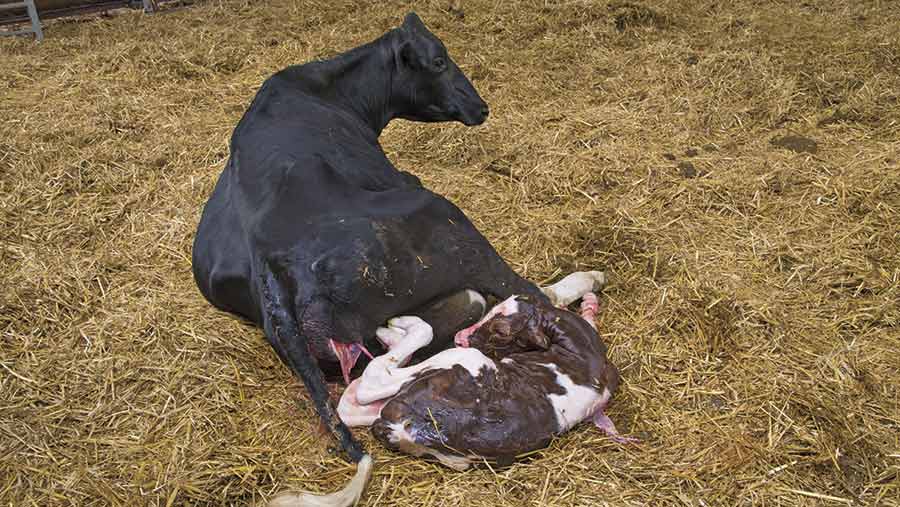Guide to preventing milk fever in your herd
Milk fever is caused when levels of calcium in the blood drop to dangerously low levels.
The scientific name “hypocalcaemia” means low levels of calcium.
Calcium is responsible for allowing nerves and muscles to work properly; when calcium levels drop too low the signs that are seen directly reflect nerve and muscle problems.
Calcium is a mineral that is usually very well controlled by the body’s systems and so it is only in extreme situations that the disease will occur.
See also: Step-by-step guide to avoiding losses at calving
Normally, the body will have a number of mechanisms that kick in to ensure that vital calcium levels in the blood are maintained at normal levels.
For example, increased absorption of calcium from the gut may take place or small amounts of bone may be resorbed to release the calcium they contain.
Which cows are at risk?
The time after calving is a period when there is a sudden and very dramatic increase in calcium demand as milk production starts.
The body has to find vast quantities of calcium from a standing start and in some cases the body simply cannot cope, the blood calcium level falls and we see the dreaded signs of milk fever.
The disease is most common in higher-yielding cows, around the time of calving or in the days immediately after calving.
It is normally seen only in older dairy cows and so would be extremely unusual, but not impossible, in first-calving heifers.
It is more common in older cows because they tend to have higher milk yields, but also because these cows often have a more sluggish control mechanism and it may take too long to react to the sudden demand for calcium.
Channel Islands breeds are more likely to suffer with the disease, as a result of the high-quality milk they produce.
Dry cows with low blood magnesium levels are also more likely to get milk fever.
If you suspect this is a problem it may be worth getting your vet to take some blood samples from dry cows to investigate.

© FLPA / John Eveson/REX/Shutterstock
What are the symptoms?
In the early stages, animals may be excitable or twitchy, but this rapidly changes and animals become dull and unable to stand.
If left untreated, they will rapidly deteriorate and will go on to die of heart failure.
All the signs are caused by problems with muscles and nerves.
The cow is unable to stand and needs rapid treatment or it will die.
The disease may also affect sheep but it is generally far less marked and frequently occurs in conjunction with other deficiencies.
What are the long-term impacts of milk fever?
As well as the obvious costs of treatment – and possibly the loss of a cow – the disease has many hidden costs.
Cows that suffer with milk fever are likely to have more problems with infertility, mastitis and metritis following the disease and milk yields are frequently affected.
Treating the milk fever itself may just be the tip of the iceberg in terms of costs.
It is hard to know accurately how common this disease really is in the UK.
Some herds suffer very badly with the disease, while others only rarely see a case – and sometimes it is hard to find an obvious difference between the two.
How can you prevent milk fever?
There are some important measures that may help prevent milk fever. We know that if a cow is kept on a diet that is low in calcium during the dry period, especially the late dry period, her mechanism for maintaining blood calcium will be on full alert and so should kick in at the first sign of trouble.
In cows that have a diet rich in calcium during the dry period, the systems may have got a bit lazy and so may take a few hours to start working when the sudden demand for calcium starts.
In the few hours it takes for these systems to start working properly there may be a very sudden and dangerous drop in blood calcium and hence we see a case of milk fever.
It is really important to take expert advice on how best to feed dry cows.
Minerals designed for milking cows frequently have high levels of calcium, but if these are fed to dry cows they may cause problems – so it is important to check this aspect of the diet very carefully.
The practice of running in a bottle of calcium to high-risk cows to be on the safe side should be avoided whenever possible.
It may seem an obvious course of action to take with cows where there is known to be a problem, but this can give rise to a situation where the cow’s own calcium control systems get confused – they think there is plenty of calcium available and so they become less active, making the problem worse in the hours ahead.
Where milk fever seems to be a recurrent or ongoing problem, it is really important to get some expert advice and investigate where things may be going wrong.
Careful attention to dry cow management and feeding is essential and expert advice should be sought before making any changes.
There are a number of products available, which may help in preventing milk fever. But it is always important to take expert advice before using these to ensure they are appropriate and cost-effective for your own situation.
